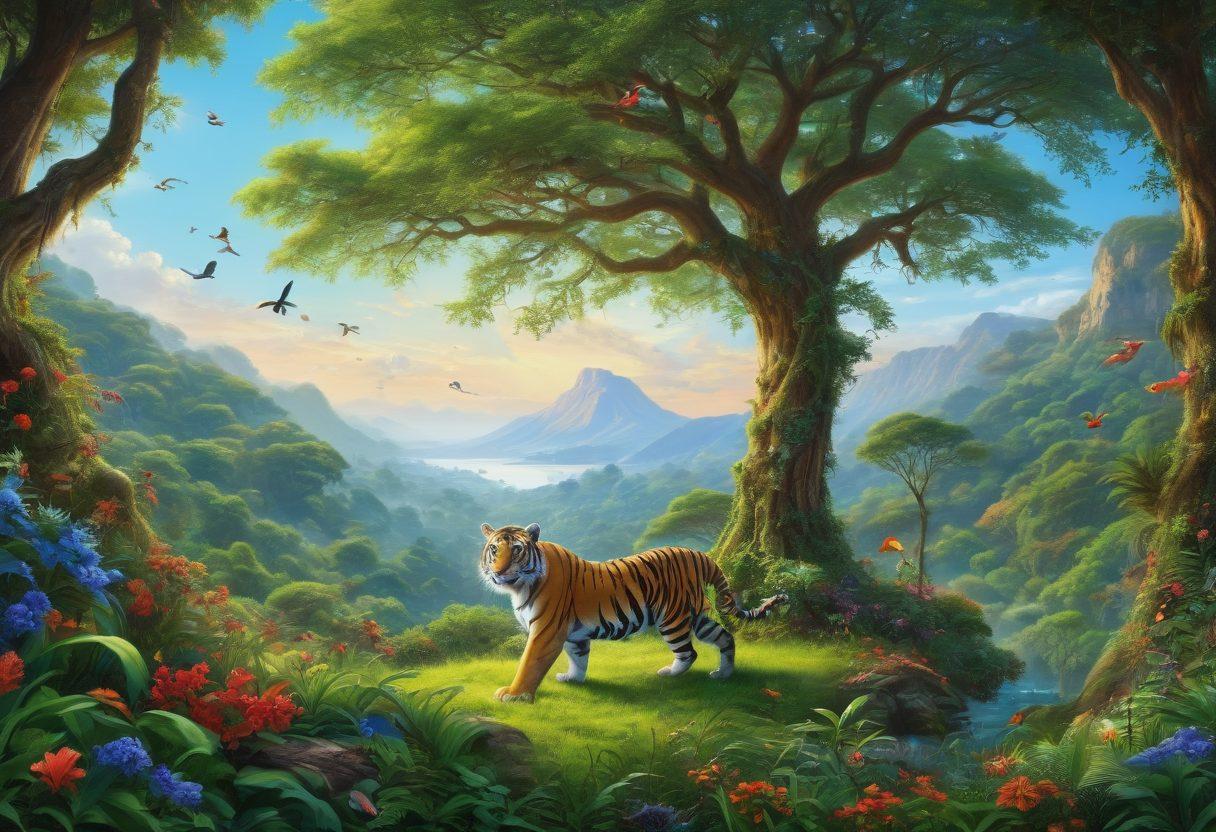Confronting the Crisis: How the IUCN Red List is Key to Protecting Our Planet's Biodiversity
The world is a treasure trove of life, teeming with flora and fauna that sustain us all. But as we forge ahead in the 21st century, biodiversity faces a crisis, and many species are on the brink of extinction. Have you ever paused to wonder about the unsung heroes fighting to protect our planet's majestic wildlife and delicate ecosystems? Enter the IUCN Red List, a vital tool developed by the International Union for Conservation of Nature. This groundbreaking initiative illuminates the status of species around the globe, helping us understand the endangerment levels and the urgent need for conservation efforts.
The IUCN Red List serves as a global barometer for the health of biodiversity. Imagine walking through a dense forest, every rustle of leaves a reminder of a fragile ecosystem at play. Now, think about how many of those creatures are classified as threatened species, their habitats under siege from environmental impact caused by human activities. Whether it’s habitat destruction, climate change, or pollution, the factors driving biodiversity loss are numerous and complex, yet they all lead to a critical point: species evaluation. The IUCN allows us to see which species are slipping toward the precipice of species extinction, inspiring urgent action for their preservation.
Why is the IUCN Red List so crucial? The answer lies in its meticulous classification system. The list ranges from Least Concern to Critically Endangered, providing a clear blueprint for wildlife protection and habitat conservation. When you see an animal categorized under 'Endangered,' it’s not just a label; it’s a call to arms. It prompts governments, organizations, and individuals to adopt sustainable development practices and prioritize species recovery. As a society, we must ask ourselves: what can we do to change the trajectory for our most endangered neighbors?
Moreover, the Red List does more than just flag at-risk species; it also highlights success stories. Conservation efforts can turn the tide—when we come together to restore habitats, enforce legal protections, and promote ecological balance, we often witness incredible recoveries. For instance, the recovery of the Arabian Oryx and the California Condor stand as a testament to the real-world implications of effective conservation measures. These triumphs fuel our hope and demonstrate the impact of thoughtful and cooperative action on global biodiversity.
In conclusion, understanding the IUCN Red List is not merely an academic exercise; it’s a call for awareness and action. Each entry on the list tells a story—a tale of survival, struggle, and the potential for recovery. By actively engaging in biodiversity preservation efforts and advocating for animal welfare, we can contribute to a legacy of species diversity that future generations will inherit. So, are you ready to take the first step in protecting wildlife and preserving our planet’s biodiversity? Remember, every small action counts, and together, we can build a sustainable future where nature thrives once again.
The Role of the IUCN in Preventing Species Extinction and Promoting Ecosystem Health
In the vast and vibrant tapestry of life on Earth, each thread—every species, every ecosystem—plays a vital role in maintaining the ecological balance. But what happens when these threads begin to fray? Enter the IUCN, or the International Union for Conservation of Nature, the guardian of global biodiversity. Their mission is clear: confront the growing crisis of biodiversity loss across the planet, where species extinction looms ever closer for many threatened species. With their comprehensive red list, the IUCN not only brings attention to the alarming state of flora and fauna but also lights a path towards recovery and sustainable development.
Have you ever paused to consider the weight of a single bee? It’s astonishing to think that this humble insect alone contributes to a third of the food we consume. Yet, bees, alongside countless other species, find themselves on the precipice of extinction. The IUCN helps us contextualize these urgent realities through its species evaluation process, which classifies the conservation status of wildlife and raises awareness of endangerment. The red list becomes a pivotal tool that strengthens our resolve to act, reminding us that protecting wildlife is not just an environmental issue; it's a vital ingredient for human survival and well-being.
Imagine a world devoid of the melodious calls of songbirds, the quiet rustling of trees harboring precious critters, or the vibrant hues of tropical reefs. This troubling prospect is what motivates countless individuals and organizations to rally behind the IUCN’s conservation efforts. As we dig deeper into their work, the stories embedded within the red list reveal an urgent plea: when we lose a species, we lose a piece of ourselves. How many other lives will be affected if we fail to protect biodiversity? These questions propel us into action, echoing the universal truth that every lost species marks a step backward in our journey toward ecological preservation and sustainability.
The role of the IUCN extends far beyond alarms and warnings; it actively champions habitat conservation and species recovery. Through collaborative efforts with local communities, scientists, and governmental bodies, the IUCN has developed strategies that not only promote wildlife protection but also ensure that geographical regions thrive sustainably. From habitat restoration projects to educational programs that empower future generations, the IUCN emphasizes that every individual has a role in fostering species diversity and protecting ecosystems. What can you do in your own backyard to support this mission? Perhaps planting native flora or advocating for local conservation initiatives could be impactful steps.
Ultimately, the IUCN’s work serves as a reminder that biodiversity loss is a challenge we all share. With their red list illuminating the path forward, we must recognize that addressing environmental impacts and prioritizing animal welfare is crucial for our survival. From the smallest microorganism in the soil to the largest mammals roaming the land, each entity is linked in a complex web of life we cannot afford to disrupt. As stewards of this planet, let us embrace the lessons offered by the IUCN and commit ourselves to action. After all, the legacy we leave is one of abundance or scarcity—what will you choose?
From Threatened to Thriving: How Conservation Efforts Can Restore Our Planet's Biodiversity
Imagine a world where vibrant ecosystems flourish, where every species lives in harmony, and nature's beauty thrives in every corner of the globe. This is the vision we all share, yet reality tells a different tale. With the urgent threat of biodiversity loss looming, the role of the IUCN - the International Union for Conservation of Nature - becomes not just crucial but imperative. This organization’s red list serves as a wake-up call, highlighting threatened species and shedding light on our planet's delicate ecological balance. Can conservation efforts truly turn the tide for endangered species?
The journey from threatened to thriving isn't an impossible dream; it's a remarkable story of hope and perseverance. Conservation efforts, fueled by science and community engagement, can restore our planet’s biodiversity. Take, for instance, the inspiring story of the California condor. Once on the brink of extinction, this iconic bird has made a dramatic comeback thanks to habitat conservation and dedicated wildlife protection programs. "It’s not just about saving one species; it’s about preserving the symphony of life that defines us all," remarks a passionate conservationist. How can we replicate such success for other flora and fauna?
At the heart of this battle against endangerment lies the crucial process of species evaluation. By systematically assessing the conservation status of various species, the IUCN helps prioritize efforts, ensuring resources are allocated where they are most needed. This systematic approach not only addresses immediate threats but fosters a culture of sustainable development and environmental conservation, creating a stronger foundation for species recovery. How can we, as individuals, amplify these conservation initiatives in our own communities?
Habitat restoration stands as a beacon of hope in the fight against species extinction. From reforestation projects to wetland rehabilitation, each restoration endeavor breathes new life into ecosystems struggling under the weight of environmental impact. By recognizing our role in this delicate interplay, we can engage in promoting ecological balance. The words of environmental leaders- "We do not inherit the earth from our ancestors; we borrow it from our children" - resonate deeply. It compels us to take action and consider how our choices today shape tomorrow's biodiversity landscape.
The journey of protecting wildlife and restoring biodiversity is a collaborative effort that requires participation from all sectors of society. Whether through volunteer work, supporting local conservation initiatives, or advocating for stronger wildlife protection laws, every small step counts. When we come together, fueled by a shared passion for preserving our planet's natural beauty, we can turn back the tide of biodiversity loss. Will you be a part of this transformative journey towards a thriving world?


